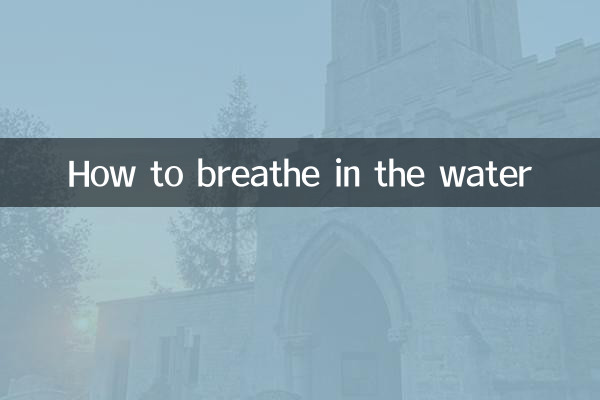How to breathe in the water: A complete analysis of swimming breathing skills
Swimming is a full-body exercise, and ventilation is one of the most critical techniques during swimming. Mastering correct ventilation techniques can not only improve swimming efficiency, but also avoid choking and fatigue. This article will combine the hot topics and hot content on the Internet in the past 10 days to give you a detailed analysis of how to breathe in the water.
1. Basic Principles of Breathing in Swimming

The core of ventilation is to ensure adequate oxygen supply to the lungs by coordinating breathing and movement rhythms. Here are three key points for breathing while swimming:
| Key points | Description |
|---|---|
| breathing timing | Take a quick breath in as you turn your head to the side or lift out of the water |
| exhalation pattern | Exhale slowly and evenly through your nose or mouth underwater |
| Movement coordination | Breathe in sync with strokes and kicks |
2. Breathing skills for different swimming styles
The ventilation methods for each swimming style are slightly different. The following are the key points for breathing for four common swimming styles:
| Swimming style | ventilation techniques | Common mistakes |
|---|---|---|
| freestyle | Rotate the head 45 degrees with the body and ventilate on one side | Raising your head too high causes your body to sink |
| breaststroke | Inhale as you lift your arms inward, and exhale as you extend your arms forward. | Excessive inhalation time affects rhythm |
| backstroke | Breathe naturally and keep your face above the water | Excessive head tilt |
| butterfly stroke | When your arms are out of the water, raise your head and inhale quickly | Ventilation timing is inaccurate |
3. Hot topics related to swimming and ventilation in the past 10 days on the Internet
According to the Internet popularity analysis, the following are the recent popular discussions about swimming ventilation:
| topic | heat index | Main content |
|---|---|---|
| Breathing tips for beginners | 85% | How to Overcome Your Fear of Water and Establish a Breathing Rhythm |
| Freestyle bilateral ventilation | 78% | Advanced ventilation techniques for balanced body development |
| underwater breathing training | 72% | Master the rhythm of exhalation by blowing bubbles |
| Prevention of choking while swimming | 65% | Analysis of causes and solutions for choking on water |
4. Frequently Asked Questions
Q: Why do I always choke on water when ventilating?
A: Choking on water is usually caused by incomplete exhalation or improper inhalation timing. It is recommended to practice exhaling underwater first to ensure that the lungs are empty before inhaling.
Q: Should I exhale through my nose or mouth?
A: Most coaches recommend exhaling through the nose underwater and inhaling through the mouth at the surface. But it can be adjusted according to personal habits. The key is to maintain the breathing rhythm.
Q: How to extend the ventilation interval?
A: Vital capacity can be increased through aerobic training while optimizing movement efficiency to reduce oxygen consumption. However, it is not recommended for beginners to deliberately extend the ventilation interval.
5. Ventilation training methods
Here are three effective breathing training methods:
| training method | Operation steps | training objectives |
|---|---|---|
| One-arm arm training | Hold the board with one hand and do only one-arm paddling and ventilation. | Focus on breathing rhythm |
| Intermittent ventilation tour | Breathe every 3-5 strokes, gradually increasing intervals | Increase lung capacity |
| Land simulation training | Mimic swimming movements and breathing on land | Build muscle memory |
6. Summary
Mastering correct breathing techniques is the key to improving your swimming skills. Whether you are a beginner or an advanced swimmer, you need to choose an appropriate ventilation method according to your own situation and develop a natural breathing rhythm through continuous practice. Remember, good ventilation techniques not only allow you to swim farther, but also make swimming easier and more enjoyable.
It can be seen from the analysis of recent hot topics that swimming ventilation skills have always been the focus of swimming enthusiasts. I hope the structured analysis in this article can help you better understand how to breathe in the water and take your swimming skills to the next level.

check the details

check the details